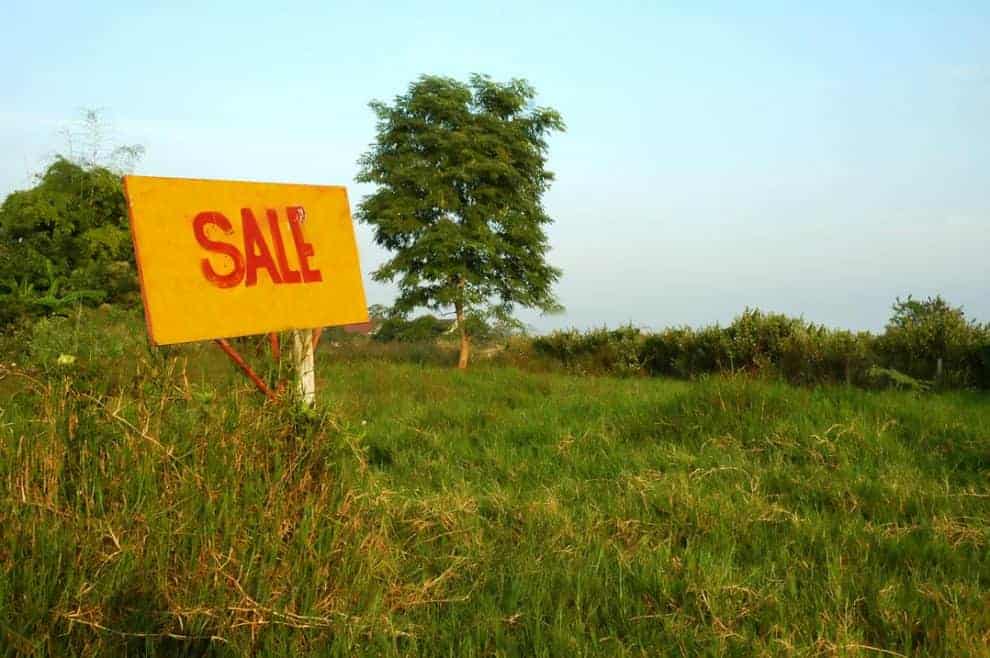Some tracts can sell with a single phone call just because they are that desirable or – like quality farmland – just in big demand. But let’s be honest – most land needs a period of time on the market to find the right buyer for the right price. If it’s cheap enough, it’ll sell. If it’s in big demand, it’ll sell. But what can you do if your tract is not in those two fast-moving categories? Let’s consider a few steps that can help.
None of these are a silver bullet solution to your land selling immediately, but taking care of some of these items will certainly make your tract more desirable to buyers who are becoming more and more discriminating.
1. Decide if you really want to sell. This seems simple enough but you’d be surprised at the number of owners who call a land agent, spend all day showing him the property and completing the paperwork to list the tract. They spend weeks fielding phone calls and emails from the listing agent with questions and offers from potential buyers…only to still be wondering if they really want to sell it. This situation is usually the real meaning behind the statement “If it sells, it sells…if it doesn’t, it doesn’t.” It’s common for people to be in a position to not have to sell a piece a property – and that’s a good position to be in. But an owner needs to make a decision that the property has a price and if he gets that price he’ll sell. Or if she gets an offer close to it, she really needs to think it through. That old saying “the first offer is often the best offer” is true more times than not. Being uncertain about your intentions to sell can cost you money.
2. Make a good first impression. If you were buying a house, the last thing you’d want to see is the current owner’s dirty clothes in the middle of the floor, a sink full of dishes or a car on blocks in the front yard. Those don’t make a positive impact on a buyer when he shows up to look. Well, neither does a gate that won’t swing open, roads that haven’t been bush-hogged all summer or piles of trash and old appliances scattered around just off the main road. A little cleaning up and clipping the roads goes a long way in making a good first impression.
Just like a lived in home will have dings and battle scars, so will your land. No one expects it to be perfect. But take a look around and see what can be done to simply give it a fresher look. Hiring someone for a couple hundred dollars to simply bush hog the roads and trails in early summer could have a big impact on the buyers your land agent brings to see your property.
3. Eliminate the problems buyers don’t want to inherit. That property line dispute you’ve had with Joe may seem like a little annoyance to you, but any new buyer will likely see it as a potential landmine he’d prefer to avoid. He’ll just go buy something else. There are a whole list of issues that may be things we don’t want to tackle, but most recreational land buyers are not looking for more problems…especially ones they may pay $2500 / acre for! They just want a nice place to hunt and bring their family and friends. Those issues need to be corrected before your property goes on the market. Here is a list of common problems that don’t pass along very well:
No Legal Access – Most buyers avoid this situation like the plague. Talk to someone to guide you on getting the access you’ve always used made official and recorded in the courthouse. This step will likely cost you some money and some time, but it will make your property more valuable. It will also help sell it in a reasonable time period. If you can’t secure legal access then be prepared to price the property accordingly.
Boundary Line Disputes or Uncertainty – People want to know where the lines are when they look at a tract. They want to see the corners marked. Get some prices and consider having a survey done. A survey will also clear up acreage issues that may come up prior to a sale that would cause delays or even a blown deal. If you have good corners, you can also hire a forester to lay in your lines. He can paint the lines or just simply flag them. You could go back and paint the flagged lines. Boundary disputes will come up with a serious buyer and a good land agent. It will get discovered and likely ruin the deal. Talk to your attorney and make a plan to get a permanent resolution to it.
Unopened Successions or Partial Interests – You have to have good title to be able to sell your land to most buyers. Unless buyers are familiar with partial interests, or you’re selling it well below market value or you’re selling interests in a larger tract (like a hunting club) you’re wasting your time trying to sell an undivided share to the general market place of buyers. Property you inherited from a family member may be “yours” in sentiment, but it’s not yours in title until the succession is complete and the judgment of possession names you as successor in title. Be sure that family property you have is 100% yours in title before you try to market it for full price.
Encroachments – If you know that your neighbor’s barn is across the property line, get it resolved. There are also ways to manage encroachments so as not to allow it to become a form of adverse possession (where possession leads to ownership) over time. Sometimes encroachments can carry over to new owners with no real issues if they’ve been managed properly. Deal with it today so it’s not a bigger problem tomorrow.
These are a few of the major issues that must be handled prior to putting your land on the market – and not just put off on new buyers – if you want the best price in the quickest reasonable time.
4. Roads, Trails & Crossings. Your tract may be drop dead beautiful down by that cypress slough, but if we can’t get buyers down there to it…well, you get the point. Sellers will typically underestimate the value in passable roads, trails and creek crossings. But buyers notice them, or lack of them, right away. And they put more value on them being there than it usually will cost to put them there. Most buyers don’t want to pay $450,000 for a project. They want to be able to close at 11:00 a.m. and be riding their 4-wheeler on the place before dark. You and I know that a decent dozer operator can cut a lot of trails for $100/hr. over a couple days and that a 36″‘ culvert can get us across that creek in the back, but most buyers don’t solve that problem themselves. If you invested the time and/or money to get some of this done, you’d be half way to selling the tract before the buyer even shows up. Don’t think that you need all-weather rock roads everywhere. Sometimes just 4-wheelers trails, bush-hogged and 1 and a 1/2 or 2 dozer blades wide, is enough to get around the tract and show off the highlights. Make the roads and crossings fit the type tract it is and the price you want to ask for it.
5. Price it Right. One of RecLand’s best agents says this almost daily…”If no one’s calling about it (your land), it’s priced too high.” He’s right. However, all the high-roller action in the farm land market, pie-in-the-sky promises from weak land agents and what “land is selling for in ________” (fill in your own unreasonable comparative area here) causes some people to expect the sun, moon and the stars for their 40 acre land-locked cutover. In our region of the country, if it’s priced right – not under-priced! – but priced right, it will get some attention, some calls and will sell in a reasonable time.
Sometimes a buyer with different motivations will pay way more than typical market value for a tract. But that’s not the norm. And waiting for that buyer to come along will likely cost you time and money in lost opportunity.
Get a good idea of what the market value of your tract is in a range. I’d rather hear someone say a tract will probably sell in the $1400-$1600 / acre range than try to hit the bull’s eye with “I’ll get you $1450 / acre for it.” He doesn’t know that for sure unless he already has a deal in mind and may be leaving some money on the table by not giving it some time on the market. The range of market value, when exposed for a period of time to many land buyers, lets you price it a little above the top of the range. This lets serious buyers know you are for real and presents the opportunity to get at or near the top of the range if it’s a desirable place. When you get offers in the range, you can feel confident in making a selling decision knowing you’re selling it for what it’s worth.
Sometimes a property has enough uniqueness to it that we are not certain where the market values it. Or a seller insists on a much higher asking price than we recommend. In these cases we have strategies to help accommodate unusually high asking prices in order to meet the demands of the tract and still try to get it sold in a reasonable time.
Don’t fall into the “Let’s ask (sun, moon & stars) for it and see if someone will pay it.” This is a bad idea if your goal is to sell the place for its real market value. Serious buyers will just avoid your listing believing that they’d be wasting their time doing any due diligence or trying to deal with that seller. They’ll go look at more reasonable deals.
Every real estate company has overpriced listings. It’s impossible to completely avoid. Have a reasonable idea of actual market value and what your selling goal is regarding time frame. Then price your tract accordingly.
Good land agents will guide you through the items listed here – and others that are relevant to your particular tract – to help you get the most money you can within the quickest reasonable time frame. These items have made this list because they’ve been discovered through many land showings and deals made. Give yours tract the edge it needs in a competitive market by doing the extras that will set it apart from the rest.
This content may not be used or reproduced in any manner whatsoever, in part or in whole, without written permission of LANDTHINK. Use of this content without permission is a violation of federal copyright law. The articles, posts, comments, opinions and information provided by LANDTHINK are for informational and research purposes only and DOES NOT substitute or coincide with the advice of an attorney, accountant, real estate broker or any other licensed real estate professional. LANDTHINK strongly advises visitors and readers to seek their own professional guidance and advice related to buying, investing in or selling real estate.










In many real estate transactions,”value” can only be guessed at. There of course is what the seller is asking. What the agent says are “comparable sales” in the neighborhood. Or what an appraiser estimates. Everyone’s got an opinion,But are they Buyers? That is why an Auction create the most “true value” for buying and selling real estate.
Good article Pat. You offer some good advice to people selling rural real estate here.